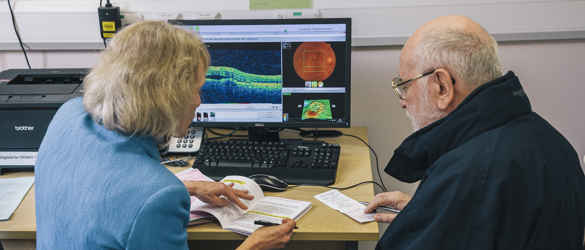
Fluorescein angiography
What is fluorescein angiography?
A fluorescein angiography (FA) is a way of studying what is happening at the back of your eye. The blood in your body flows through tiny blood vessels. It helps the doctor see exactly where the blood vessels are in your eye, their size and any problems they might have. This helps the doctor make a diagnosis.
How is it done?
After a vision check, you’ll be given eye drops to make your pupils dilate. Local anaesthetic cream will be applied to your arm and a small amount of the yellow dye, fluorescein, will be injected into your blood through a vein in your arm.
This dye will circulate around the body and eventually pass through the blood vessels in your retina. At this point the medical photographer will take a very quick series of photographs of your eye, which will then be shown to a doctor so that they can make a diagnosis.
Is fluorescein angiography painful?
Most people do not experience any unpleasant side effects from an FA. Your skin and urine will go slightly yellow and this may last for up to 24 hours. Drinking plenty of water afterwards will help flush the dye out of your system more quickly.
Occasionally you may feel nauseous or sick. Some people feel itching or tingling, which can be treated immediately with an antihistamine.
It is best to stay in the hospital for at least 30 minutes following the procedure, just in case you have any usual delayed reactions to it.
Are you worried or confused about upcoming tests?
Call the Macular Society Helpline on 0300 3030 111 or email help@macularsociety.org
Last review date: 02 2022
What to do after diagnosis
Find advice on what to do after a diagnosis of a sight loss condition. Macular Society is here to guide you through what to do next and to help you get any support you may need.
Support for you
We provide free information and support to those with macular disease, along with their family and friends, to help people keep their independence.
Free confidential advice and support
Call our helpline on 0300 3030 111
Lines are open 9am - 5pm Monday to Friday
About the Macular Society Helpline



